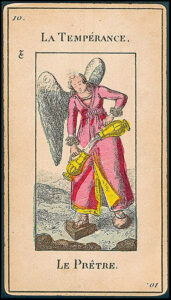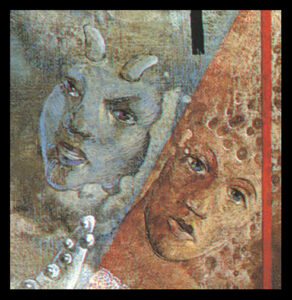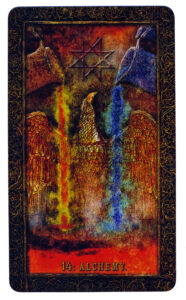
In the centuries since Tarot was invented in fifteenth-century Italy for gaming purposes, the cards have gathered numerous occult, metaphysical, and mundane motifs, meanings, and applications. The numerous design alterations that mark this accrual of influences are important indicators of the lengthy path to today’s popular divination and meditation deck. This paper offers a brief summary of just one of these influences—that of alchemy—on the changing appearance of just one card—Temperance—and its associated meanings from the fifteenth to the twenty-first centuries.
Alchemy has been practiced in many countries for many centuries with the goal of completing the “great work,” which is defined as the discovery or creation of the philosopher’s stone. This stone was supposed to transform baser metals into silver or gold and confer eternal life. The primary process by which the great work was to be accomplished was basic chemistry: “solve et coagula” or dissolve and coagulate. Essentially, alchemists sought ways to purify substances by repeatedly breaking them down, often by distillation, and then allowing them to solidify again in four primary stages identified as nigredo (black), albedo (white), citrinatas (yellow), and rubedo (red).
Alchemy is described in a number of ancient manuscripts that are now readily available in various internet archives and as commercial publications. Among these is the extraordinary Splendour Solis (1582) attributed to Salomon Trismosin, which confirms that the alchemical process was not solely about chemistry, but spiritual development as well (Fabricius, 1976, 1994, p. 242). The second illustration in the manuscript (fig. 1) shows the magician or adept “exclaiming: ‘Let us go and seek the nature of the four elements’” (Fabricius, 1976, 1994, p. 242) while pointing to the round beaker associated with distillation. A later image (fig. 2) shows a cleansed and transformed bird. Joannes Fabricius (1976, 1994) tells us that “the text [accompanying the original] explains the event as symbolising the return of the soul: ‘The philosophers say that whosoever can bring to light a hidden thing is a master of the art …’” (p. 242). The subject, having been created in the nigredo stage, is now purified and prepared for coagulation into a new unity that Carl Jung—who made much of alchemy as a psychological process akin to his “individuation”—described as consisting of man with his anima and woman with her animus and both with their shadows.
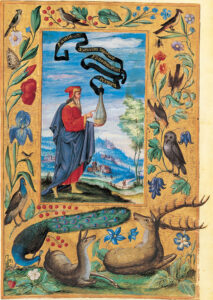
Fig. 1. An alchemist with flask. Image from Salomon Trismosin’s Splendour Solis. 1582. Public domain image.
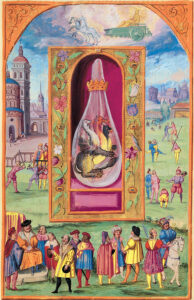
Fig. 2. Dragon with three heads. Image from Salomon Trismosin’s Splendour Solis. 1582. Public domain image.
The processes of individuation, of self-study and self-exploration, as well as the idea that there are correspondences or connections between the world above and the world below and indeed between all manner of symbolic and material systems, underpin many of the hundreds and thousands of new Tarot decks created in the twentieth and twenty-first centuries. Not surprisingly in this context, the apparent coincidence that there are twenty-two Tarot trumps in the modern deck and twenty-two illustrations in Splendour Solis has not gone unnoticed: Marie Angelo reproduced the illustrations from this manuscript as the trumps of the Splendor Solis Tarot (2019, 2020) adding white borders and labels to the originals. The image of the alchemist with flask becomes the Magician, the dragon with three heads becomes Temperance, and so forth. This dramatic example notwithstanding, alchemy is far from prevalent in today’s decks, but it has brought about a deep revision of the meanings associated with the Temperance card.
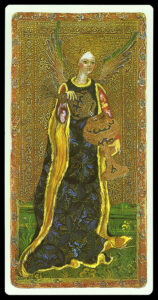
Fig. 3. Cary-Yale Visconti Tarocchi Deck Facsimile and reconstructed edition created from hand-painted original produced in Milan c. 1445. 9.7 × 19 cm. © 1985 U.S. Games Systems. Illus. reproduced by permission of U.S. Games Systems. All rights reserved.
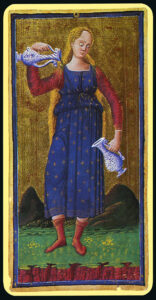
Fig. 4. Visconti-Sforza Pierpont Morgan Tarocchi Deck. 15th century. Facsimile edition recreated from hand-painted original produced in Milan c. 1450. 9 × 17.5 cm. © 1975 U.S. Games Systems. Illus. reproduced by permission of U.S. Games Systems. All rights reserved.
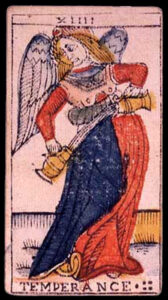
Fig. 5. Jean Dodal Tarot by Jean Dodal (of Lyon). Marseilles-style Tarot. 1701/1715. Public domain image.
In both the Cary-Yale (fig. 3) and Visconti-Sforza (fig. 4) Tarot, Temperance represents one of the four cardinal virtues. The slightly earlier Cary-Yale deck includes cards for the three theological virtues of Faith, Hope, and Charity, and three of the cardinal virtues: Temperance, Strength or Fortitude, and Justice, while Prudence is absent, missing, or possibly indicated by another card. The Visconti-Sforza deck does not have cards for the theological virtues, but it does have cards for Temperance, Strength, and Justice. In both Cary-Yale and Visconti-Sforza Temperance cards, a feminine figure pours liquid from one container to another: the usual assumption is that she is diluting wine with water in order to promote temperance in those consuming it. The same basic image, usually with a winged figure and with red and blue colors dominant, was maintained in printed decks, such as the Jean Dodal Tarot (fig. 5).
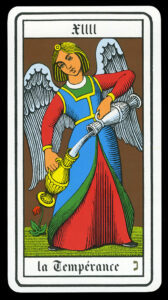
Fig. 7. Oswald Wirth Tarot. Originally designed by Oswald Wirth with direction from Stanislas de Guaita in 1889. This card U.S. Games edition © 1976. 7 × 13.1 cm. Illus. reproduced by permission of U.S. Games Systems. All rights reserved.
The earliest Tarot deck known to have been created specifically for divination is that by Jean-Baptiste Alliette (1738–1791), better known as Etteilla; this deck is also the first to show what appears to be a deliberate incorporation of alchemical symbolism. Temperance (fig. 6) is an angel who pours a liquid from a pitcher in her left hand to one in her right. She has a small sun motif on her forehead, likely indicating perfection and the purity of gold, and she stands with her left foot on a round rock, suggesting the circle or alchemical symbol for salt, and her right on a triangular rock, suggesting sulphur. Paul Huson (2004) sees the sun motif as a reinvention of a flower found on some older Marseilles-style cards (p. 122).
In 1889, the Swiss artist Oswald Wirth (1860–1943) designed a trumps-only Tarot under the guidance of the French occultist Stanislas de Guaita (1861–1897). This deck was informed at least in part by Etteilla’s and by alchemical processes. It was originally published in a hand-colored limited edition and the line drawings were later included in Wirth’s book Tarot of the Magicians (1927). The text accompanying the illustration explicitly states that the cards preceding Temperance in the trump sequence represent death and decomposition; that is, the first stage of the alchemical process. The angelic figure on the card (fig. 7) pours the “vital fluid” from a silver to a gold receptacle indicating the final purification. As Wirth explains, this process is more about psychic than material transformation,
The jars of precious metal do not correspond to crude bodily containers; they allude to the double psychic atmosphere whose natural organism is only the earthly ballast. Of these concentric containers the one, the nearer (gold, conscience, reason) is solar active; it directs the individual in an immediate way and supports its energy of the will. The other stretches beyond the first; it is lunar and sensitive (silver). Its domain is more mysterious; it is that of sentimentality, of vague impressions, of the imagination and of the unconscious on a superior level. […] What is concentrated in the silver urn flows into the [other] where condensation is completed with the view to maintaining psychic life. (Wirth, 1927, 1985, 117-118)
In addition, Etteilla’s sun motif reappears transformed into two concentric circles colored yellow and a red flower grows below the gold urn.
The French occultist Eliphas Levi (1896) was also influenced by Etteilla, although he derided the earlier author’s work and deck at every opportunity. For example, Etteilla had departed radically from the conventionalized order the cards had fallen into thanks to the universal use of the printing press and Levi asserted that they should be put back in something like that familiar arrangement. However, Levi furthered Etteilla’s project of developing correspondences for Tarot by integrating an even broader range of them taken from Kabbalah and alchemy. His description of the Temperance card reads as follows:
Hieroglyph, TEMPERANCE, an angel with the sign of the sun upon her forehead, and on the breast the square and triangle of the septenary, pours from one chalice into another the two essences which compose the Elixir of Life. (Levi 1896; 2013, Ch. XXII)
The creation of the “elixir of life” is one goal of the “great work” and obviously Levi thought Etteilla was right to include the sun motif on his angel’s forehead. The septenary may refer to the seven metals of traditional alchemy: lead, tin, copper, iron, mercury, silver, and gold; and /or the seven planets of traditional astrology: Saturn, Jupiter, Venus, Mars, Mercury, the Moon, and the Sun; and /or any number of other sets of seven.
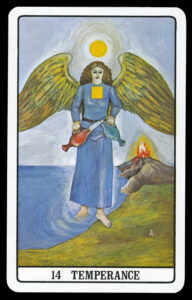
Fig. 8. Robert Wang, The Golden Dawn Tarot. © 1977 Robert Wang and Israel Regardie. Neuhausen, Switzerland: AGM AGMüller. 7.9 × 12.7 cm. Illus. reproduced by permission of Robert Wang. All rights reserved.
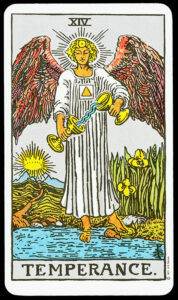
Fig. 9. Pamela Smith (artist) and Arthur Waite. The Rider-Waite Tarot®. 1909. Stamford, CT: U.S. Games Systems © 1971. 7 × 12 cm. Illus. reproduced by permission of U.S. Games. All rights reserved.
The members of the Hermetic Order of the Golden Dawn established in London in 1888 studied the works of Etteilla, Levi, and others who emphasized correspondences with Tarot. One of the Order’s founders, MacGregor Mathers, and his wife Moina Mathers created a new Tarot that initiates were expected to make copies of. Golden Dawn member Israel Regardie (1907–1985) (1971, 1989) wrote of the “usual” form of the Temperance card found in the Order’s “Ritual of the Portal” that
It represents an Angel with the Solar emblem of Tiphareth on her brow, and wings of the aerial and volatilising nature, pouring together the fluidic Fire and the fiery Water—thus combining harmonising and temperating [sic] those opposing elements.
One foot rests on dry and volcanic land in the background of which is a volcano whence issues an irruption [sic]. The other foot is in the water by whose border springs fresh vegetation, contrasting strongly with the arid and dry nature of the distant land. On her breast is a square, the emblem of rectitude. The whole figure is a representation of that straight and narrow way of which it is said “few there be that find it” which alone leads to the higher and glorified life. […] (p. 218)
Robert Wang presents his Golden Dawn Tarot (1977) as an authentic rendering of the Golden Dawn deck and his Temperance card (fig. 8) is consistent with Regardie’s description. The sun motif applied by Etteilla and affirmed by Levi appears above the figure. The adaptation of the placement of the angel’s feet so that one rests on land and the other in water may have been inspired by the bible: “And he had in his hand a little book open: and he set his right foot upon the sea, and his left foot on the earth” (Revelation 10:2 King James Version). The specification of “fluidic Fire” and “fiery Water”—here indicated by the red and blue pitchers respectively—and the literal addition of a volcano and a body of water seem to be articulations of the alchemical elements. The coloured pitchers, volcano, and water reappear in many subsequent decks.
Golden Dawn member Arthur E. Waite (1857–1942) was certainly aware of the conventions adopted by the Order. When he and artist Pamela Colman Smith (1878–1951) collaborated on the Rider-Waite-Smith Tarot (1909), they maintained, but also elaborated on the Golden Dawn image (fig. 9).
A winged angel, with the sign of the sun upon his forehead and on his breast the square and triangle of the septenary. I speak of him in the masculine sense, but the figure is neither male nor female. It is held to be pouring the essences of life from chalice to chalice. It has one foot upon the earth and one upon waters, thus illustrating the nature of the essences. A direct path goes up to certain heights on the verge of the horizon, and above there is a great light, through which a crown is seen vaguely. Hereof is some part of the Secret of Eternal Life, as it is possible to man in his incarnation. All the conventional emblems are renounced herein.
So also are the conventional meanings, which refer to changes in the seasons, perpetual movement of life and even the combination of ideas. It is, moreover, untrue to say that the figure symbolizes the genius of the sun, though it is the analogy of solar light, realized in the third part of our human triplicity. It is called Temperance fantastically, because, when the rule of it obtains in our consciousness, it tempers, combines and harmonises the psychic and material natures. Under that rule we know in our rational part something of whence we came and whither we are going. (Waite, 1910, 1983, 124-25)
The “great light” or sun rises (or sets) beyond distant mountains, its appearance echoing the ornament on the figure’s brow, as well as that of the sun on the Death card, which rises (or sets) between two pillars identical to those on the Moon card. The irises may well be a reference to Iris, who carried messages from the gods to humans on a rainbow. Waite’s words combined with this imagery are affirmations of many alchemical associations that go far beyond the original virtue, ranging from harmonizing and tempering to the notion of eternal life. By way of the tremendous popularity of the Rider-Waite-Smith deck, these motifs and their associated meanings are echoed in many contemporary versions of the card.
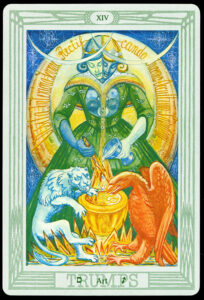
Fig. 10. Aleister Crowley and Frieda Harris (artist). The Book of Thoth. 1944. 9.5 × 14 cm. Illus. reproduced by permission of Ordo Templi Orientis, University of London, and AGM-Urania. All rights reserved.
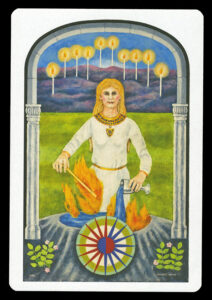
Fig. 11. Robert Wang. The Jungian Tarot. 1988. Marcus Aurelius Press edition 1990 or 2001 (?) U.S. Games edition with pamphlet © 2018. Stamford, CT: U.S. Games, Systems. 7.5 × 11 cm. Illus. reproduced by permission of U.S. Games Systems. All rights reserved.
Aleister Crowley (1875–1947) (1944, 1991), also a Golden Dawn initiate, wrote more explicitly about the alchemical imagery and meanings integrated into the version of Temperance that he and Frieda Lady Harris (who falsely claimed the title Lady Frieda Harris) (1877–1962) created for their Thoth Tarot in the late 1930s and early 1940s (fig. 10).
The robe of the figure is green, which symbolizes vegetable growth: this is an alchemical allegory. In the symbolism of the fathers of science all “actual” objects were regarded as dead; the difficulty of transmuting metals was that the metals, as they occur in nature, were in the nature of excrements, because they did not grow. The first problem of alchemy was to raise mineral to vegetable life; the adepts thought that the proper way to do this was to imitate the processes of nature […] The state of the great work therefore consisted in the mingling of the contradictory elements in a cauldron. This is here represented as golden or solar, because the Sun is the Father of all Life, and (in particular) presides over distillation. […] Behind the figure […] is a glory bearing an inscription VISITA INTERIORA TERRAE RECTIFICANDO INVENIES OCCULTUM LAPIDEM, “Visit the interior parts of the earth: by rectification thou shalt find the hidden stone.” Its initials make the word V.I.T.R.I.O.L., the Universal Solvent […]
This “hidden stone” is also called the Universal Medicine. It is sometimes described as a stone, sometimes as a powder, sometimes as a tincture. It divides into two forms, the gold and the silver, the red and the white; but its essence is always the same [… Vitriol] represents a balanced combination of the three alchemical principals, Sulphur, Mercury and Salt. […] (pp. 102-104)
Harris’s illustration fully articulates Crowley’s description; the most influential point to observe here is that watery fire and fiery water are combined in a cauldron in a very literal representation of the combination of opposites.
After his commercial edition of the Golden Dawn Tarot (fig. 8), Robert Wang published a new deck titled The Jungian Tarot (1988) in which all of the card designs express the affinity between alchemy and individuation. He recreated the Temperance (fig. 11) figure herself as the philosopher’s stone, or mediator, that unifies opposites—shown as the now familiar fire and water, but here also intended to reference the conscious and unconscious mind. This unification is treated as part of the same process that requires darkness or blackness (nigredo) before movement toward light (albedo) or understanding (Wang, 2017, p. 192). Further, Wang (2017) associates this card with what Jung called active imagination, which involves focusing on some interior image and allowing one’s unconscious mind to create a flow of additional images from it. Jung, Wang points out, even called the first image in an active imagination exercise by the alchemical term “the prima materia” (p. 195).
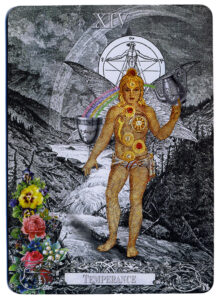
Fig. 12. Arthur Taussig. The Alchemical Visions Tarot. Arthur Taussig © 2019. Newburyport, MA: Re Wheel/Weiser Books. 12.7 × 17.8 cm. All rights reserved.
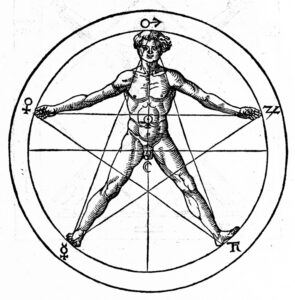
Fig. 13. Image of a human body in a pentagram from Heinrich Cornelius Agrippa’s Libri tres de occulta philosophia. Symbols of the sun and moon are in center, while the other five classical “planets” are around the edge. Heinrich Cornelius Agrippa, Libri tres de occulta philosophia. 1531. Public Domain. Also reproduced Alexander Roob, Alchemy & Mysticism (Taschen, 1997) p. 536.
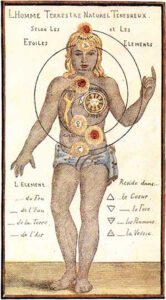
Fig. 14. Johann Georg Gichtel (1638–1710), Theosophia Practica (Amsterdam, 1696). Public Domain. Reproduced in Alexander Roob, Alchemy & Mysticism (Taschen, 1997) p. 559.
Taking their cue from Etteilla, Levi, Waite, Crowley, and others, a number of twentieth and twenty-first century artists have created decks partly or entirely based on alchemical correspondences in Tarot. Adam McLean (2006) compiled a list of at least some of these decks including John Sandbach’s Golden Cycle Tarot (1976), Tarot de Gwen (1979), Guido Gillabel’s De Hierofant’s Alchemisten Tarot (1987), Rafal Prinke’s Alchemical Tarot (1988), Dirk Gillabel’s Alchemical Tarot (late 1980s) and Hermetic Tarot (1990), Tarocchi di Paracelso (1993), Robert Place’s Alchemical Tarot (1995), Full Metal Alchemist (2004), Alchemical Emblems Tarot (2006), and Alchemical Wedding Tarot (2006). Illustrations for these, many of which were limited editions and are out-of-print, are available by searching McLean’s Tarot Database, other Tarot websites, and the artists’ blogs.
Some of the more recent and more thoroughly developed alchemy-influenced decks include the Splendor Solis Tarot, mentioned above, and Arthur Taussig’s The Alchemical Visions Tarot (2019). Taussig borrows motifs and images from public-domain alchemical treatises and collages them (no source information provided) into new contexts. His Temperance figure (fig. 12), for example, is taken from a work by Cornelius Agrippa (1531) (fig. 14) and the design above its head is from Gichtel’s Theosophia Practica (1696) (fig. 13). New meanings are proposed for the cards that were apparently inspired by Jung and a wide range of cultural traditions, but rarely specify the connection with alchemy indicated in the deck title.
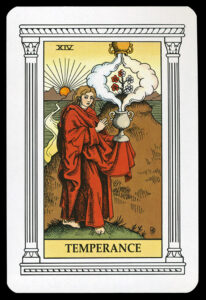
Fig. 15. Robert M. Place. The Alchemical Tarot. First Edition. London: Thorsons. 8 × 12 cm. © Robert M. Place 1995-2020. Illus. reproduced by permission of Robert M. Place. Deck republished as The Alchemical Tarot Renewed, 5th Edition by Hermes Publications. All rights reserved.
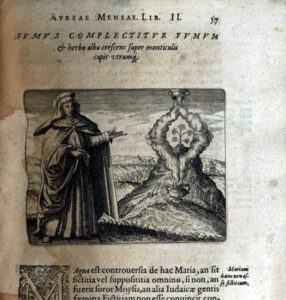
Fig. 16. Plate from Michael Maier (1568?-1622), Symbola aureae mensae duodecim nationum. 1617. Public Domain. Retrieved from Internet Archive.
Of all the Tarot artists who have worked with alchemical imagery, the best known by far is Robert Place, who has created a number of alchemy-based decks. The earliest of these, The Alchemical Tarot (1995), has been re-released in numerous editions. Place borrows and then reinvents motifs and images from numerous alchemical texts for his cards, and includes references to his visual sources directly in the guidebook for those curious enough to backtrack on his research. For example, his image of Temperance (fig. 15) reinvents a plate from a book published in 1617 (fig. 16). Rather than the usual Tarot Temperance figure pouring liquid from one container to another, here, as Place (1995) explains, the “water of life flows down from the heavens […] and rises as steam in imitation of the natural process called precipitation. […] Within the opening can be seen the Tree of Life, with five branches each bearing a five-petalled flower. These represent the five senses of humankind, as well as the four elements plus spirit, or the quinta essential” (p. 104). Place acknowledges the significance of the Rider-Waite-Smith deck to alchemical Tarot by means of a visual quotation: a path leading off into the mountains where a sun is rising.
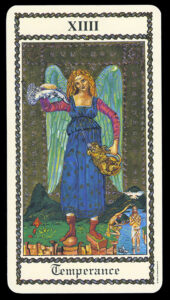
Fig. 17. Luigi Scapini. Medieval Scapini Tarot Deck. © 1984. Stamford, CT: U.S. Games Systems. 7.1 × 13.2 cm. Illus. reproduced by permission of U.S. Games Systems. All rights reserved.
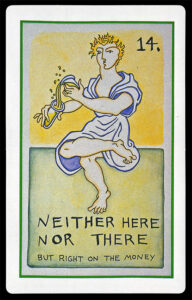
Fig. 18. Brian Williams, PoMo Tarot. © 1994. New York: HarperSanFrancisco, 1994. 9.5 × 15.1 cm. All rights reserved.
While many contemporary artists are not particularly concerned with the deep accrual of meanings—alchemical or otherwise—informing modern day Tarot imagery, like Place, at least some take the study of history very seriously. For example, in Luigi Scapini’s Medieval Scapini Tarot Deck (1984) Temperance (fig. 17) is informed by the careful study of at least three historical decks: the figure stands on the brink of a cliff like that in the Visconti-Sforza card and she stands with her feet on two stones as does Etteilla’s figure. Here, however, one stone appears to be square, rather than triangular, and the other round. Possibly, this adaptation was intended to make a stronger connection to the philosopher’s stone, which is sometimes represented by a circle inside a square. In addition, as in the Wirth card, she pours liquid from a silver to a golden pitcher and a red flower grows beside her. The mountains in the background may suggest the Rider-Waite-Smith card, but where Waite may or may not be implying an association between the card and Christian notions of resurrection and eternal life, Scapini states this meaning literally by incorporating the image of John the Baptist baptizing Jesus with a dove above them.
In his light-hearted PoMo Tarot (1994) (fig. 18), Brian Williams (1994) presents alchemy as nascent science by replacing Temperance’s familiar jugs with test tubes; he says the liquid resulting from the combination of whatever is in them is “probably some benign alchemical concoction.” The card refers to “the desirability of tempering, diluting, balancing, mixing and matching. Swirl a little yin into your yang, or vice versa, the character seems to say, for a balanced psychosexual cocktail” (p. 27). That said, the title Williams gave the card—Neither Here Nor There—sounds a little like a tongue-in-cheek answer to Waite’s description of its meaning as helping us to know “something of whence we came and whither we are going” (quoted above).
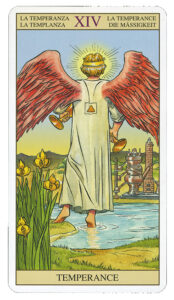
Fig. 19 and 20. Left (full card) and right (detail): Raul and Gianluca Cestaro (artists), Giordano Berti and Tiberio Gonard (authors), Pietro Alligo (cards, idea, script, supervision), Tarot of the New Vision. Torino, Italy: Lo Scarabeo, 2005. All rights reserved.
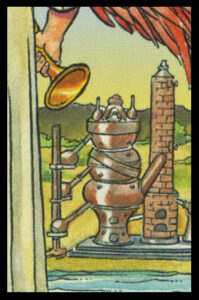
Waite and Smith’s extraordinary Rider-Waite-Smith Tarot is also behind every single image of the Tarot of the New Vision, a deck designed so that viewers are looking at the back of the Rider-Waite-Smith figures and beyond. Recognition of the deep connection that has evolved between Temperance (fig. 19) and alchemy is apparent in the incorporation of an athanor; that is, a coal oven used to heat a distiller (fig. 20). As the authors of the deck’s guidebook explain, “The contents of this distiller, when evaporating, rise in accordance to the differing weights of the substances in them. They end up as deposits in the three vases on the left” (Berti, et al., 2005, p. 45). Other motifs from the original card are also included or suggested: the triangle inside the square and the irises are plainly visible, while the path implies the unseen mountains and sun and the glow around the figure’s head suggests the forehead sun motif.
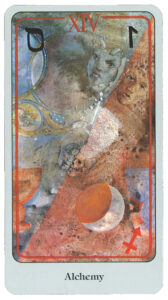
Fig. 21. Hermann Haindl. The Haindl Tarot. Stamford, CT: U.S. Games Systems © 1990. 7 × 12.7 cm. Illus. reproduced by permission of U.S. Games. All rights reserved.
Herman Haindl indicates his understanding of the connections between the Temperance card and alchemy by actually renaming the card “Alchemy” (fig. 21). Rather than representing the elixir of life by the mixing of fire and water, he incorporates the alchemical image of the hermaphrodite as a symbol of the ultimate unity, that of male and female. Thus, he places a male face on one side of a diagonal line and a female face on the other (fig. 22) (Pollack, 1990, p. 124-25).
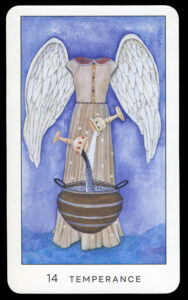
Fig. 23. Alexandra Eldridge (artist) and Tony Barnstone (guidebook), The Radiant Tarot. © 2021. Website: https://alexandraeldridge.com/ Newburyport, MA: Red Wheel/Weiser Books. 7.5 × 12.4 cm. Illus. reproduced by permission of Alexandra Eldridge. All rights reserved.
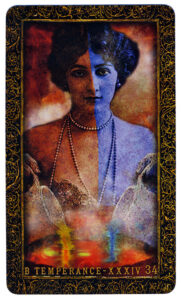
Fig. 24. Tinker’s Damn Tarot Temperance cardDoug Thornsjo. Cards two-deck set Tinker’s Damn Tarot and Mantegna. Legacy Edition [156 cards and pamphlet]. Revised Second Edition. Waterville, ME: Duck Soup Productions, 2018. 7 x 12 cm. Illus. reproduced by permission of Doug Thornsjo. All rights reserved.
A number of artists have emphasized a direct association of alchemy with human artistic creativity; thus, Alexandra Eldridge reinvents the Temperance figure (fig. 23) as an invisible spirit who pours liquid from two goblets—one with red and one with blue jewels around the rim—into a cauldron that floats above the ground. In the guidebook, Tony Barnstone explains the meaning of the card with reference to the search for truth through balance and moderation, going beyond notions of temperance as a virtue to alchemy by making it about blending extremes to establish unity. He quotes Jung on the importance of integrating opposite aspects of one’s self to become whole. The “Creative Practice” section is subtitled “Visual Alchemy” and includes quotes and exercises identifying art-making as alchemy, as the blending of opposites, and the turning of base matter into gold (Eldridge and Barnstone, 2001, p. 44-45). The red and blue jewels on the goblets are likely a restating of the watery fire and fiery water, a visualization also used with considerable dramatic effect in Doug Thornsjo’s Temperance and Alchemy cards for his Tinker’s Damn Tarot (fig. 24) and Mantegna (fig. 25) decks respectively. The pearls on the Tarot card, like the phoenix on the Mantegna card, speak of creative transformation as processes in nature, real and mythical.
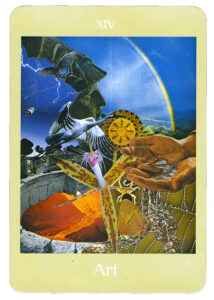
Fig. 26. Ken Knutson (artist) and James Wanless (Ph.D). Voyager Tarot. © 1985. Merrill-West Publishing. 9.6 × 14 cm. Illus. reproduced by permission of the author, James Wanless www.jameswanlessoracle.com. Voyager Tarot is now published by Quarto. All rights reserved.
James Wanless, like Crowley and Harris, actually retitles his Voyager Tarot (1985) Temperance as “Art” (fig. 26), and like Eldridge and others, he merges the card’s accrued alchemical meanings with creativity: he understands creativity to be an alchemical art involving the dissolving of the old to create something new. He reinvents the alchemical references to the combining of fiery water and watery fire as a description of how new ideas come from the unconscious to consciousness like lightning or fire and the “water feelings” are what bring those ideas into material being. He further associates the cauldron, which some contemporary Tarot artists use instead of pitchers, as a potential limitation insofar as ideas may be contained and not acted on (Wanless, 1986, p. 25-26). Even in this radically redesigned card, there are many references to the Rider-Waite-Smith version. The rainbow suggests irises: the rainbow was the path Iris is said to have travelled when delivering messages from the gods to humans. It arcs above a photograph of mountains and a basketry design suggestive of the sun, both of which are motifs in the Rider-Waite-Smith card. New additions include mercury or silver overflowing from cupped hands to gather around a moth or butterfly—a creature that aptly and appropriately symbolizes metamorphoses and transformation.
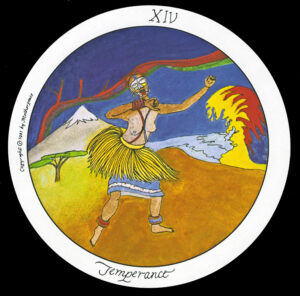
Fig. 27. Vicki Noble and Karen Vogel. Motherpeace Round Tarot. Stamford, CT: U.S. Game Systems. 11.4 cm. dia. Illus. reproduced by permission of Vicki Noble. and Karen Vogel. Motherpeace © 1981. Website: Motherpeace.com. All rights reserved.
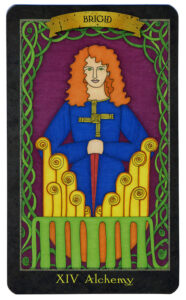
Fig. 28. Ellen Lorenzi-Prince. Dark Goddess Tarot. 2013. Atglen, PA: Schiffer, 2020. 7.5 x 12.7 cm. Illus. reproduced by permission of Ellen Lorenzi-Prince. All rights reserved.
Alchemical associations have expanded the possible meanings of the Temperance card as cardinal virtue to include an emphasis on balance or moderation and also all kinds of transformation, including creativity, and by association, healing. For example, Vicki Noble (1983) not only identifies the Motherpeace (1981) Temperance card (fig. 27) with alchemy, she links it with shamanic traditions. The card image depicts a fully initiated shaman in control of all opposites and thus able to transform imbalance into the balance necessary for healing. Noble cites Crowley’s identification of this card with Art as an important suggestion for how the energies that might otherwise be harmful can be used or unified so that they are part of life rather than destruction (pp. 107-108). The references to fire and water are maintained by a volcanic-looking mountain and a cresting wave; the dancing figure also has one red and one blue anklet.
Ellen Lorenzi-Prince has aligned all the cards of her Dark Goddess Tarot (2013) with female deities and mythological figures. She identifies Temperance as “Alchemy—Brigid Irish Goddess of Craft, Art, and Healing” (fig. 28). Brigid herself is associated with fire and water in that she is a goddess of the fire and hearth and also of water and wells. She thus presides over both the forge and tempering of metals, and the cauldron and blending of substances. Brigid, like the Motherpeace shaman, is a master of healing and transformation.
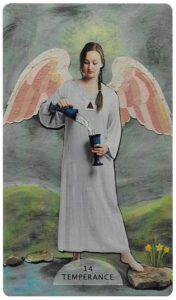
Fig. 29. Shelley Carter. Temperance. The Triumph of Life Tarot organized by Andrew McGregor. 2017. 7 x 12 cm. Illus. reproduced by permission of Shelley Carter. All rights reserved.
In a further alignment of Tarot with healing and modern-day science, Andrew McGregor of The Hermit’s Lamp store in Toronto, Ontario, organized The Triumph of Life Tarot (2015). Numerous artists created and contributed cards to this deck, which he then marketed: all profits went to cancer research. The Temperance card for this deck was created by Shelley Carter, who also organized the collectively created Elora Tarot (2013). In that earlier deck her daughter appears as the High Priestess; in The Triumph of Life Tarot she is a Rider-Waite-Smith-inspired Temperance (fig. 29): a winged-angel whose clothing is marked by the triangle in a square and stands with one foot on land and one in the water. The interpretation of the card Carter offers in the downloadable pdf reads
It is the random nature of cancer that some will get it. Of those, some survive and some die. Temperance tells us to live our life with balance and grace, despite what is happening, so that, no matter the outcome, we will have made the best of our time here. (Carter in McGregor, 2015)
Carter dispenses with all the alchemy-inspired markers suggesting “something of whence we came and whither we are going.” There are no paths, no suns, no hints of messages from the gods, just wings of hope aligned with the science-associations of the deck itself. There are, however, substitutions: an individual’s face rather than an allegorical one, and, rather than irises suggesting that aid will come from the gods (if at all), there are daffodils. Daffodils, those cheerful harbingers of spring, are the symbol of the Canadian Cancer Society’s Daffodil Campaign “to fund nationwide support programs that offer comfort and connection—and world-leading research to transform the future of cancer” (Canadian Cancer Society website). Temperance is thus metamorphosed into a sparse and tightly focused image with one message: we can find ways to restore health and extend the lives of real individuals in the here and now. The elixir of eternal life may or may not ever be discovered on this or that side of the veil, but the Temperance card maintains its kinship with the fifteenth-century virtue in representing something that should be cultivated on the path of life, whatever its duration.
From the fifteenth through the twenty-first centuries, artists have sought to ornament Tarot cards with images that are meaningful to themselves and their patrons. In the fifteenth century, the theological and cardinal virtues were among the obvious choices for such illustrations, but changing cultural interests and the realization of an ever-lengthening list of card correspondences led to many adaptations and substitutions. Alchemy—which synchronized personal development with both processes found in nature and the search for the philosopher’s stone—had a particular impact on the figure and motifs associated with Temperance. The alchemical alignment led to the card’s association with cultural, as well as personal, transformation; creativity; healing; and, of course, modern science. All of these interpretations have contributed to the ongoing relevance of the card—and that of the deck as a whole—to modern deck users.
References
Berti, Giordano, and Tiberio Gonard (authors), Raul and Gianluca Cestaro (artists), Pietro Alligo (cards, idea, script, supervision). (2005). Tarot of the New Vision [guide book]. Torino, Italy: Lo Scarabeo.
Canadian Cancer Society. Website < https://cancer.ca/en/ways-to-give/daffodil>.
Caldwell, Ross G.R., and Marco Ponzi. (2019). Tractus de deificatione sexdecim heroum per Martianum de Sancto Alosio / A Treatise on the Deification of Sixteen Heroes by Marziano Da Sant’ Alosio with text, translation, introduction, and notes by Ross G.R. Caldwell and Marco Ponzi with Illus. from The Marziano Tarot recreated by Robert Place. Scholion Press.
Crowley, Aleister. (1944, 1991). The Book of Thoth: A Short Essay on the Tarot of the Egyptians. Stamford, CT: U.S. Games Systems, Inc.
Eldridge, Alexandra (artist) and Tony Barnstone (text). (2021). The Radiant Tarot: A Guide to the Cards. Newport, MA: Weiser Books.
Fabricius, Joannes. (1976, 1994). Alchemy The Medieval Alchemists and their Royal Art. 1976. Revised edition 1989. London: Diamond Books, 1994.
Huson, Paul. (2004). Mystical Origins of the Tarot: From Ancient Roots to Modern Usage. Rochester, VT: Destiny Books.
Levi, Eliphas. (1896; 2013). Dogma Et Rituel De La Haute Magie, Part II The Ritual of Transcendental Magic, Trans. A.E. Waite. 1896, Web edition Global Grey, 2013. Chapter XXII. The Book of Hermes.
McLean, Adam. (2006). “Lesson 15,” Adam McLean’s Study Course on the artwork and symbolism of modern tarot.
McGregor, Andrew. 2015 The Triumph of Life Tarot. The Game Crafter website < https://www.thegamecrafter.com/games/triumph-of-life>
Noble, Vicki. (1983). Motherpeace A Way to the Goddess through Myth, Art, and Tarot. New York: HarperSanFrancisco.
Place, Robert. (1995). The Alchemical Tarot [guidebook]. Hammersmith, London: Thorsons.
Pollack, Rachel (1990). The Haindl Tarot Volume I The Major Arcana. North Hollywood, CA: Newcastle Publishing, Inc.
Regardie, Israel. (1971, 1989). The Golden Dawn: A Complete Course in Practical Ceremonial Magic Four Volumes in One. Sixth edition. St Paul, Minnesota: Llewellyn Publications.
Waite, Arthur E. (1910, 1983). The Pictorial Key to the Tarot. 1910. York Beach, Maine: Samuel Weiser.
Wang, Robert. (2017). The Jungian Tarot and Its Archetypal Imagery. Stamford, CT: U.S. Games, Inc.
Wanless, James. (1986). Voyager Guidebook: Tarot Instruction Book and Manual for Voyager Tarot. Second Edition Revised. Carmel, CA: Merrill-West Publishing.
Williams, Brian. (1994). PoMo Tarot [Guidebook]. © 1994. New York: HarperSanFrancisco.
Wirth, Oswald. (1927, 1985). Tarot of the Magicians. 1927. English edition York Beach, Maine: Weiser, 1985.
